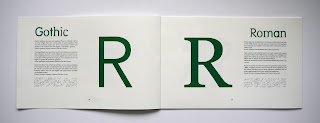Crit
The presentation above is what I showed in my group crit, showing the development of my ideas and how far I had got with the whole brief.
The main queries I had were relating to the fact that I wasn't necessarily talking about a brief history of anything, more showing the deconstruction & reconstruction of typefaces, and looking specifically into how post modern typefaces are constructed.
I also had a query relating to the DIY book page layout into how interactive it was.
General feedback was that the DIY book doesn't necessarily need me to show exactly what piece of the letters were used, or even show a finished letter altogether. That idea could be a separate book, an example book to show what could be made using typefaces, and that the DIY could be a separate bit with the given materials.
It was also said that it didn't matter that the publication wasn't a history of, as it showed understanding and that I had applied the knowledge I had done in research.
After Crit Development
As the feedback was positive and helpful, I applied it and made changes to the existing books.
Deconstruction book
Instead of having a brief history of type or post-modern typefaces, I decided to dedicate a page each to the four groups of type, of which I have used on every page of the book. I explain their characteristics and how to identify the type group of a typeface or letter on appearance.
I stayed in the format of the other pages, just changing the placing of the title so it was at the top. I used the four typefaces which I have used throughout the book on each page. I chose to use the 'R' as the example image because in each of the four typefaces there were distinct differences which could be easily seen, whereas there were a couple of letters which had similarities which might confuse the reader a little.
As well as these pages, I added a page with the definition of 'Deconstruct', essentially to explain exactly what the book was about.
I then added a contents page, with all four languages in a clear column format.
Reconstruction Book
 |
| Original Layout Design |
I got rid of the whole format and idea, and decided to simplify it down to two different elements; a book full of examples of what could be created and considered post-modern, and then a DIY element.
For the book of examples, I wanted it to be a small book which had little information, just visuals. I started by having simply the reconstructed letter and the list of typefaces used to create it.
In all white I found that it all just looked like it was floating and didn't really have a place of the page, and although it might have looked better printed, at the minute on screen it looks out of place, so because of this I added a green box behind the reconstructed letter, giving it more presence and a focal point for the page. I continued to play around with the layout now I had this extra element.
I also added the three type layouts I had created to explain briefly what post-modern typefaces were as it felt appropriate being in this book over the Deconstruction book.
Going back to the layout design I was using before, where I showed which part of the letters were being used, I decided to apply the same layout here as I felt just the letter on the page didn't really say much. So I started to play around with the layout and the three letters.
I settled on the image below because it showed all the information that was necessary, and keeps the focus on the reconstructed letterform, and less on where it came from. I also think it is the most balanced layout, where each element has it's own space and a clear place on the page. I then repeated this for every letter.
 |
| Chosen Layout |








































No comments:
Post a Comment